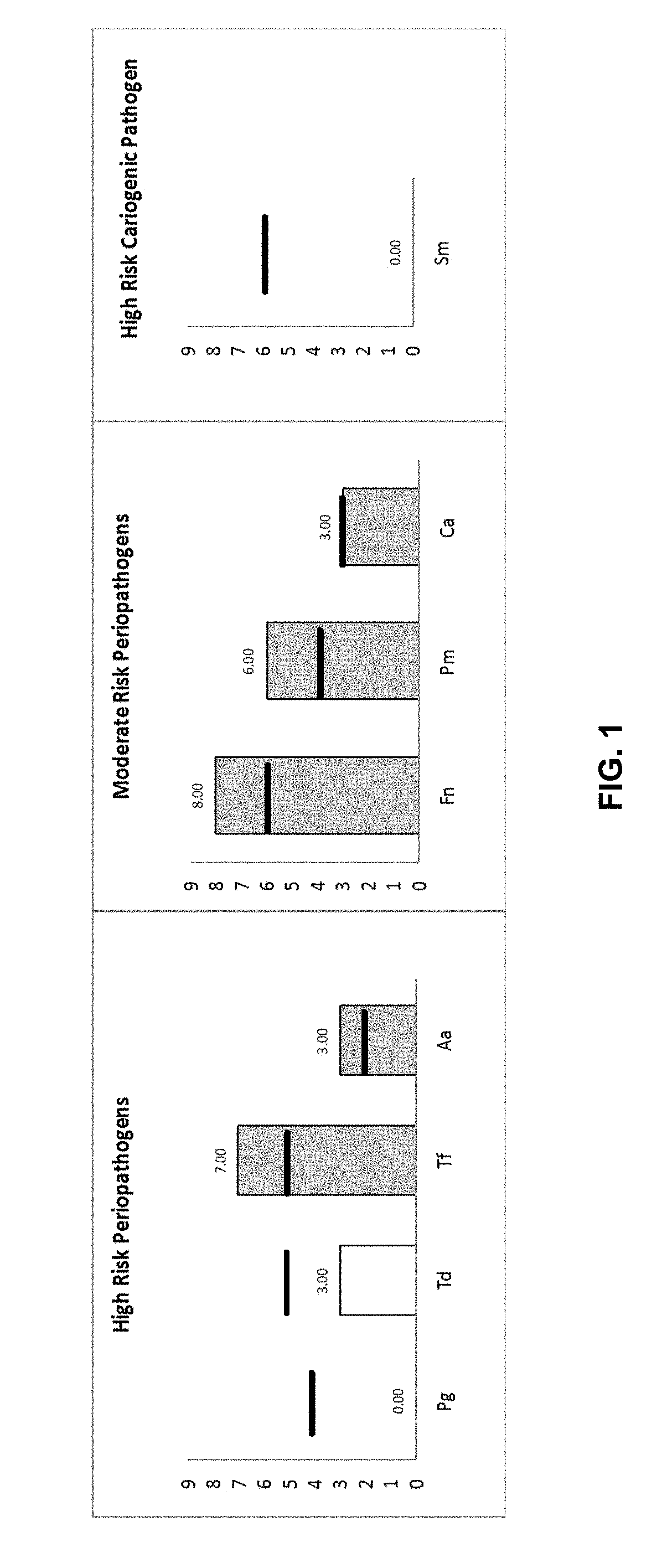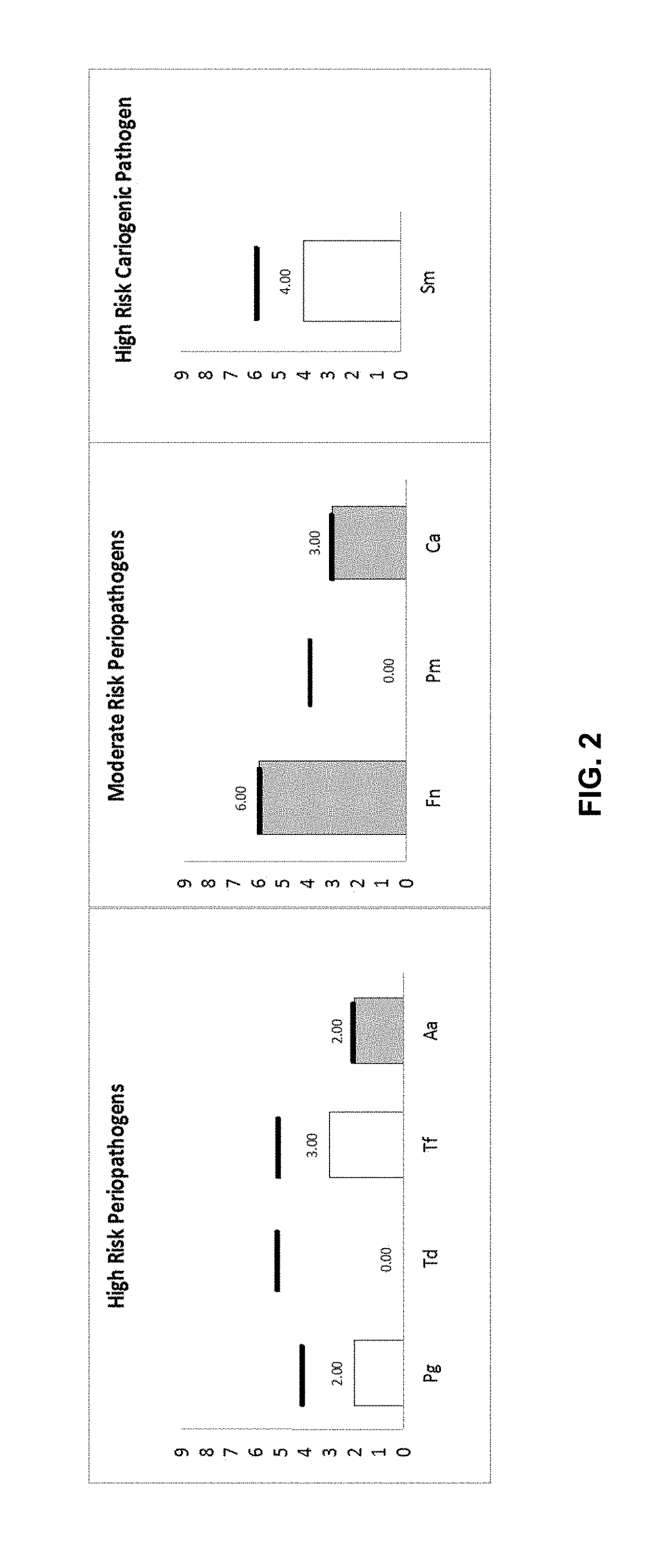Methods and kits for selecting treatment for oral infections
a technology for oral infections and kits, applied in the field of methods and kits, can solve the problems of tissue-destructive events, limited species-level causative agents, and inability to provide precise degrees,
- Summary
- Abstract
- Description
- Claims
- Application Information
AI Technical Summary
Benefits of technology
Problems solved by technology
Method used
Image
Examples
example 1
sis
[0102]a. Pre-Selection of Target Pathogens
[0103]The following eight oral pathogens were selected as targets for DNA analysis of oral samples:
Periodontal Risk Pathogens:
[0104]Porphyromonas gingivalis [Pg]—A prominent player in progressive periodontal disease, known to invade and destroy the tissues supporting the tooth that may lead to tooth loss.
Treponema denticola [Td]—An oral spirochete, strongly associated with poly-microbial periodontal infections and chronic periodontal disease progression. Its motility plays a pivotal role in tissue invasion and proteolytic activity in tissue destruction and host immunosuppression.
Tannerella forsythia [Tf]—A pathogen strongly associated with the pathogenesis and progression of destructive forms of periodontitis, particularly advanced and recurrent periodontitis. Known to adhere to host cells, invade tissues, and contribute to host immunosuppression.
Aggregatibacter actinomycetemcomitans [Aa]—An aggressive bacterium associated with juvenile p...
example 2
[0115]The results of the qPCR assays of Example 1 were evaluated, and treatment recommendations were provided accordingly.
a. Case A
[0116]The patient information and test results are provided in Table 5 and FIG. 1.
TABLE 5Patient and Test InformationPatient InformationTest InformationName of Patient: n / a (Patient A)Ordered By: n / aDate of Birth: n / aClinic Name: n / aGender: maleAddress: n / aMedical / Dental concerns: bad tasteState / Province / Country: n / aMaximum Pocket Depth: 5 mmPostal or Zip Code: n / aPeriodontal disease: moderateDate Sample Collected:Allergies: not reportedDate Sample Received:Antibiotic history: used in the last 3 monthsReport Date:
[0117]FIG. 1 illustrates the levels of target pathogens from the sample of Patient A. In summary, high and moderate risk pathogen were detected for Patient A. The detailed report was as follows:[0118]Periodontal risk: The high-risk periodontal pathogen P. gingivalis was not present. T. denticola was at the monitor level, bu...
case c
c. Case C
[0136]The test results of Case C are shown in FIG. 3, which illustrates the levels of target pathogens from the sample of Patient C.
[0137]In summary, high and moderate risk pathogens were detected for Patient C. The detailed report was as follows:[0138]Periodontal risk: High-risk periodontal pathogen A. actinomycetemcomitans was identified above the normal threshold. P. gingivalis was at monitor level and T. forsythia was within normal range. T. denticola was not detected. Moderate-risk pathogens F. nucleatum and P. micros were found above normal levels.[0139]Caries risk: S. mutans was detected above the normal range. That may increase the risk for development of dental caries.[0140]Candidiasis: C. albicans was found at higher numbers than normal level and that may predispose to oral yeast infection.
[0141]Treatment was selected and recommended based on medical history, periodontal charting, and the above report. The specific treatment recommendations for Patient C were as f...
PUM
| Property | Measurement | Unit |
|---|---|---|
| Depth | aaaaa | aaaaa |
Abstract
Description
Claims
Application Information
 Login to View More
Login to View More - R&D
- Intellectual Property
- Life Sciences
- Materials
- Tech Scout
- Unparalleled Data Quality
- Higher Quality Content
- 60% Fewer Hallucinations
Browse by: Latest US Patents, China's latest patents, Technical Efficacy Thesaurus, Application Domain, Technology Topic, Popular Technical Reports.
© 2025 PatSnap. All rights reserved.Legal|Privacy policy|Modern Slavery Act Transparency Statement|Sitemap|About US| Contact US: help@patsnap.com



